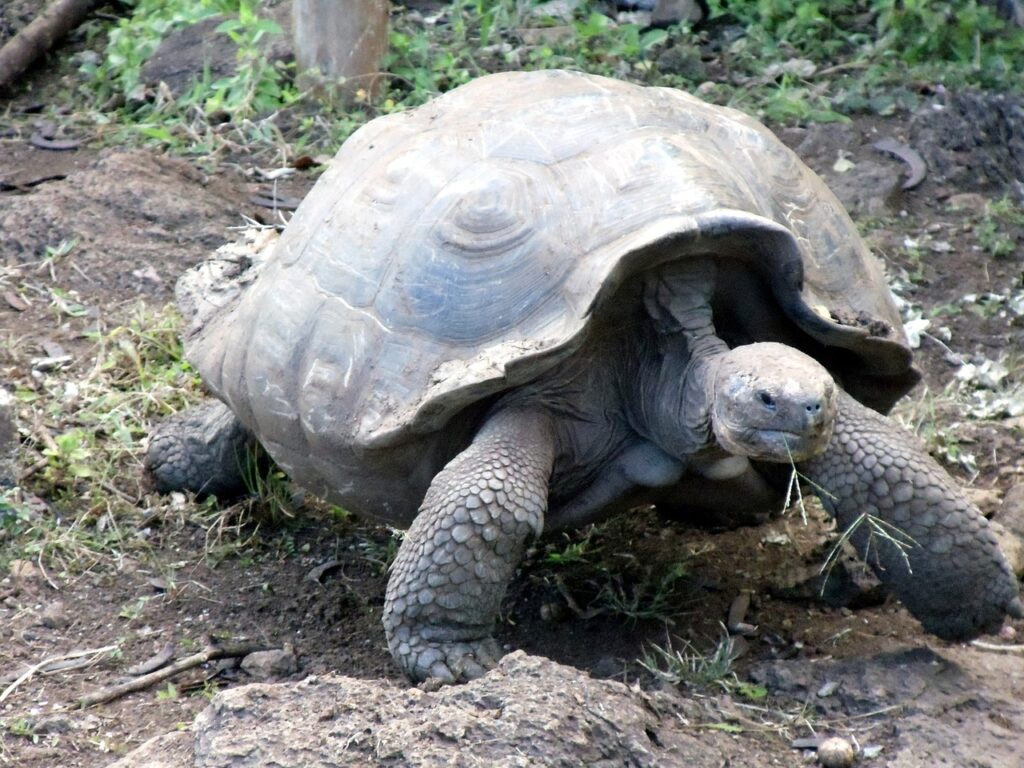Galapagos tortoises, native to the Galapagos Islands, are part of the world of biodiversity. For centuries, they’ve captivated our minds. Yet, their numbers have dwindled drastically. How many are left? An estimate says about 20,000. Still, this is a small fraction compared to their historic population.

Each species of Galapagos tortoise on different islands has its own features. For example, the Pinta Island subspecies, Lonesome George, sadly passed away in 2012. But conservation efforts continue with captive breeding programs and habitat restoration projects across multiple islands.
Help out by supporting organizations like the Galapagos Conservancy or volunteering with local wildlife centers. That way, future generations can experience the wonder of these precious creatures firsthand.
Key Takeaways
- The Galapagos tortoise population has significantly declined over the years due to human activities such as hunting, habitat destruction, and the introduction of non-native species.
- Currently, there are only around 20,000 Galapagos tortoises left in the wild, with some subspecies being critically endangered.
- Conservation efforts have been implemented to protect and restore the tortoise population, including captive breeding programs and habitat restoration projects.
- The Galapagos National Park and other organizations are working together to monitor and protect the remaining tortoises and their habitats.
- It is crucial for individuals and governments to support conservation initiatives and raise awareness about the importance of preserving these iconic and unique creatures.
Background information on Galapagos tortoises

Galapagos tortoises are legendary for their grand size and incredible longevity. They’ve been around for millions of years, with their distinctive shells and slow-paced movements being a symbol of resilience. The Galapagos Islands, where these animals reside, has influenced their evolution.
These tortoises are the biggest on Earth! They can reach up to 5 feet and weigh 500 pounds or more. This size is an advantage in their natural habitat, as it helps them reach higher vegetation and survive droughts.
What sets them apart is their saddle-shaped carapace which allows them to graze on taller plants easily. And their domed shells make it easy to access low-lying plants.
Unfortunately, hunting and destruction of habitat have reduced their population numbers. But conservation efforts have been key in preserving the species. One particular story is that of “Lonesome George“, the last known surviving Pinta Island Giant Tortoise. His discovery sparked international attention and led to research into conserving Galapagos tortoises.
Current population status of Galapagos tortoises
The population of Galapagos tortoises is worrying. Let’s take a look:
Data of the population is as follows:
| Chelonoidis nigra abingdoni | Chelonoidis nigra becki | Chelonoidis nigra darwini | Other Subspecies | |
|---|---|---|---|---|
| Population | 1 | 86 | 2,000 | 6,600 |
These creatures have long lifespans and reproduce slowly. Thus, saving them is a challenge. But, conservation efforts are promising.
One such effort is the story of Lonesome George. He was the last known individual of the Chelonoidis nigra abingdoni subspecies. He became an icon for species protection. Sadly, he passed away in 2012, without any offspring. His legacy reminds us of our duty to protect these creatures before they vanish.
The population of Galapagos tortoises is decreasing. Yet, this decline is happening at a snail’s pace.
Factors contributing to the decline in the Galapagos tortoise population
The Galapagos tortoise population is in decline due to several factors. Human activities, like farming and urban growth, have caused habitat loss, reducing food and mate access. Invasive species, such as rats and goats, also compete for resources and prey on eggs and young. Climate change is impacting vegetation distribution, diminishing suitable food sources.
It is essential to act now for their survival. We must preserve habitats, control invasive species, and mitigate climate change impacts. Conservation organizations, governments, and individuals must unite to secure a future for these majestic creatures. With collective action, we can prevent further decline and make a difference for future generations.
Let’s work together to keep the Galapagos tortoise population thriving!
Conservation efforts and initiatives for Galapagos tortoises

Conservation measures for Galapagos tortoises are essential for them to survive. Many initiatives are in place to protect and conserve their natural habitat and population. These include:
- Guarding nesting sites to avoid interference and help eggs hatch.
- Managing invasive species, for example rats and goats, to limit their influence on tortoise population and habitats.
- Restoring damaged habitats with reforestation and removal of alien plants.
- Captive breeding programs to maximize the tortoise population and maintain genetic diversity.
- Educating people about the significance of conservation and how they can help.
- Scientific research to track population patterns, recognize dangers and create effective preservation strategies.
Collaborative efforts by international institutions and the Galapagos National Park Service are also present. These associations bring together experts from around the world to share information and resources in preserving these turtles.
An emotional event in 2012 was the passing of Lonesome George, the last Pinta Island tortoise, without offspring. This emphasized the requirement for immediate conservation actions. Since then, attention has been concentrated not only on protecting tortoises, but to also stop any other species from facing similar extinction.
By remaining dedicated to these conservation efforts, we can work towards a secure future for existing Galapagos tortoises and keep them present in our world.
Interviews with experts in the field
Experts reveal that only around 25,000 Galapagos tortoises remain in the wild. Challenges such as habitat destruction and illegal hunting are faced by conservationists. To protect these reptiles, breeding programs and genetic diversity must be implemented. Research efforts are also being made to understand their ecology and behavior. International collaboration and funding are needed to support conservation initiatives. Climate change is another potential threat to their future.
Let’s join forces to avoid the complete depletion of this species. An inspiring story of a group of researchers rescuing a stranded tortoise from fishing nets highlights the dedication of those involved in conservation and the need for continued support. Interviews with experts provide valuable insights into the challenges and ongoing efforts to protect them. Public awareness and international cooperation are key in ensuring a brighter future for these iconic creatures.
Frequently Asked Questions
Q: How many Galapagos tortoises are left?
A: As of the latest estimation, there are around 20,000 Galapagos tortoises left in the wild. They are considered a vulnerable species.
Q: Are Galapagos tortoises endangered?
A: Yes, Galapagos tortoises are classified as an endangered species. They face threats from habitat destruction, invasive species, and illegal hunting.
Q: What is the main cause of Galapagos tortoise population decline?
A: Human activities and introduction of non-native species have been the main causes of population decline. Habitat degradation and destruction have had a significant impact on their population.
Q: Are there conservation efforts to protect Galapagos tortoises?
A: Yes, there are various conservation programs in place to protect Galapagos tortoises. These programs focus on habitat restoration, captive breeding, and raising awareness about their importance to the ecosystem.
Q: How long do Galapagos tortoises live?
A: Galapagos tortoises have an impressive lifespan, often exceeding 100 years. Some individuals have been known to live up to 150 years or more.
Q: Can I see Galapagos tortoises in their natural habitat?
A: Yes, Galapagos Islands offer opportunities to witness these majestic creatures in their natural habitat. However, it is important to respect their environment and follow strict guidelines to minimize disturbance.
Conclusion
The Galapagos tortoise population is in peril! There’s an urgent call for conservation efforts. Raising public recognition and stricter regulations on human activities can protect their habitats. Establishing captive breeding programs can boost their numbers. Collaborating with international organizations and researching can help create successful conservation strategies.
It’s essential to educate local communities about the Galapagos tortoises and their environment. Involving them in conservation initiatives will create a sustainable future.
Though there are considerable conservation efforts, more is needed to save these extraordinary creatures. Charles Darwin’s discoveries highlighted their fragility, thus leading to conservation initiatives – a mission we carry on today, united as guardians of nature.
References




